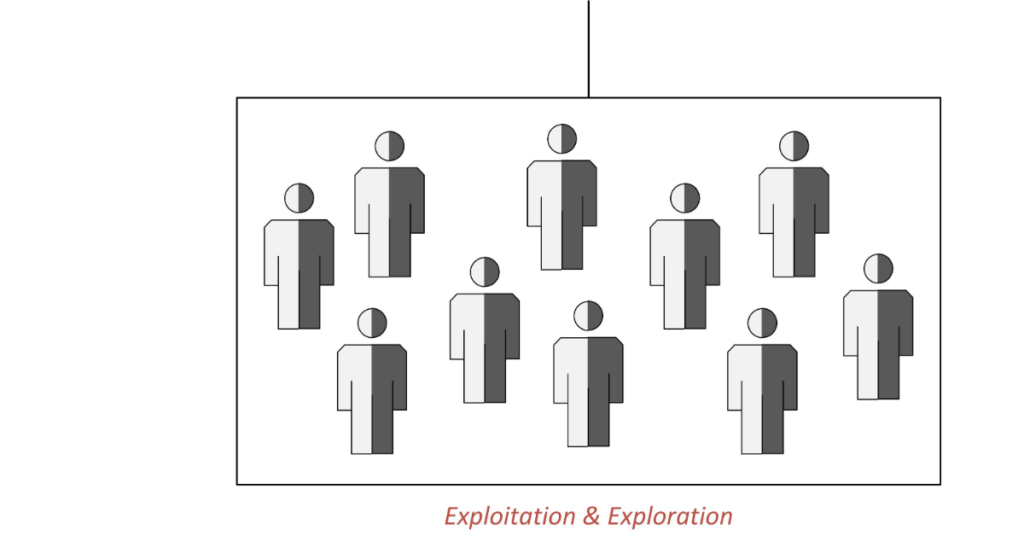
Balancing artists between efficiency and innovation
In today’s dynamic and complex VUCA world, hardly any company can afford to concentrate exclusively on using its existing competencies and optimising its existing business. Instead, it is more important to simultaneously open up new opportunities for future business areas and markets. In his bestseller, Clayton Christensen has impressively described how successful companies with an exclusive focus on their core business can be overrun by new technologies and wiped out within a short period of time.
Solution to the Innovator’s Dilemma
Companies that want to remain competitive in the long term must therefore achieve the right balance between the enhancement of efficiency in the core business (exploitation) and the focus on radical innovation (exploration). This balancing act is known as organisational ambidexterity. The term ambidexterity originates in medicine, where it refers to the ability of using both hands equally well.
For practical implementation of the concept of ambidexterity, two basic approaches have been established.
Structural ambidexterity
Under the concept of structural ambidexterity, the existing business is deliberately separated from the future business. Advocates of this approach argue that exploitation and exploration require a completely different culture and organizational structure. This creates autonomous and structurally separated exploitation and exploration units. From the large, mostly centralised and efficiency-oriented exploitation units, a high degree of conformity to clearly defined processes and strict adherence to business rules is demanded. In contrast, in the small decentralised exploration units, an open, collaborative culture and a high level of tolerance for error is fostered, which allows employees to experiment and leave familiar paths.
While structural ambidexterity provides for consistency within the distinct organisational units, this necessitates the coordination and integration of exploitation and exploration efforts at a higher level. Stanford Professor Charles A. O’Reilly and Harvard Professor Michael L. Tushman describe this as a crucial management task in their bestseller „Lead and Disrupt: How to Solve the Innovator’s Dilemma“.

Contextual ambidexterity
Due to the high costs of coordination and alignment, structural ambidexterity does not always prove to be a sensible solution in practice. Therefore, the more integrated approach of contextual ambidexterity, which does not require dual structures, is often considered a more practical alternative. Under the concept of contextual ambidexterity, exploitation and exploration are conducted simultaneously within the same business unit. This implies that a conducive context is created in the form of a combination of structures, processes and culture. For example, it must be ensured that the resources required for an exploration project can be requested even if the ROI is not already quantifiable, meaning that the tight rules and processes of the core business can be bypassed under certain conditions.
While under the approach of structural ambidexterity top management is responsible for the coordination and integration of exploitation and exploration, contextual ambidexterity challenges managers and employees to decide how best to divide their resources between the two activities. The individual’s ability to exploit and explore and to deal with the tensions between these two paradigms is thus a critical success factor for contextual ambidexterity .

The role of the individual
Regardless of whether a company adopts the approach of structural or contextual ambidexterity, the individual is a key factor. Achieving organisational ambidexterity requires ambidextrous people who are equally capable of exploitation and exploration, who are able to divide their resources sensibly, and who consider the two activities as complementary rather than conflicting.
While organisational ambidexterity has become a permanent topic in management practice and literature, the focus is rarely on the individual. This is what I want to change with my PhD dissertation. For example, I seek to find answers to the following questions:
- Who are these multi-talented people who are equally good at exploitation and exploration and even achieve synergies from these opposing activities?
- How do different people from different professions deal with the tension between exploitation and exploration?
- At what organisational level should the coordination and integration of exploitation and exploration take place and what challenges arise from an organisational, social and ethical perspective?
If you have any inputs, personal experiences or questions, please do not hesitate contacting me.
Add A Comment